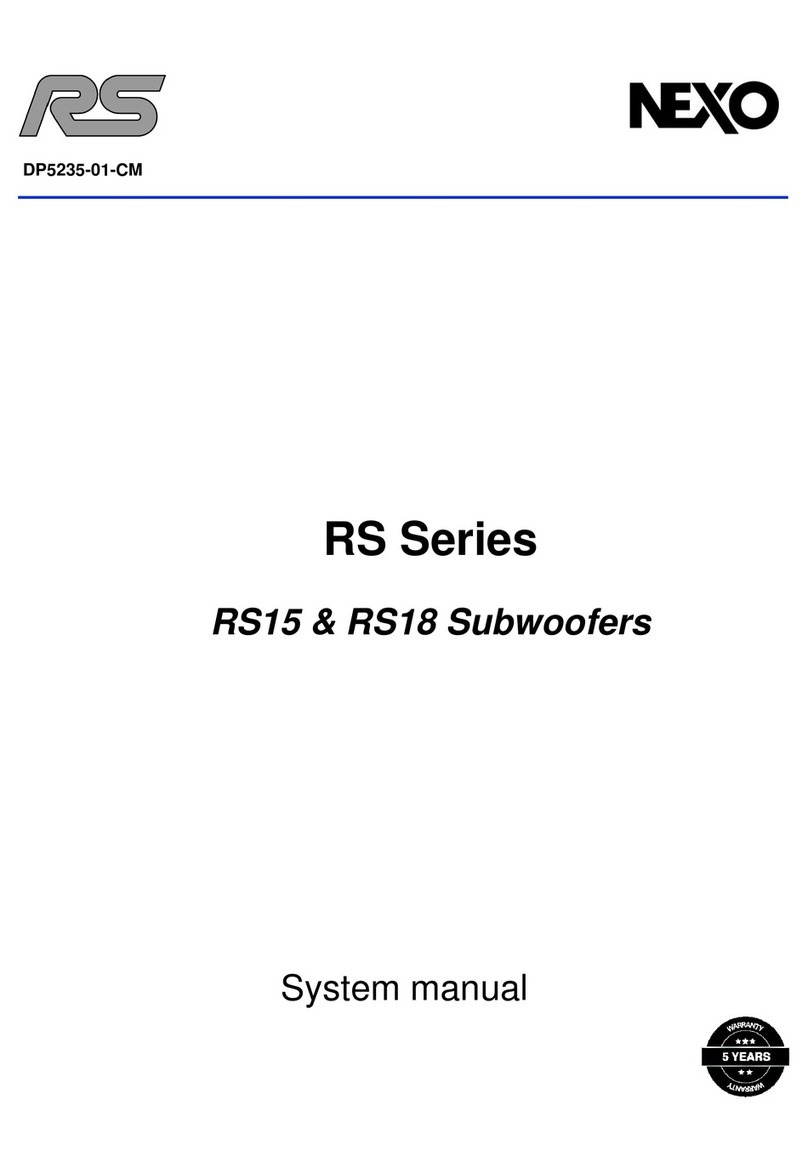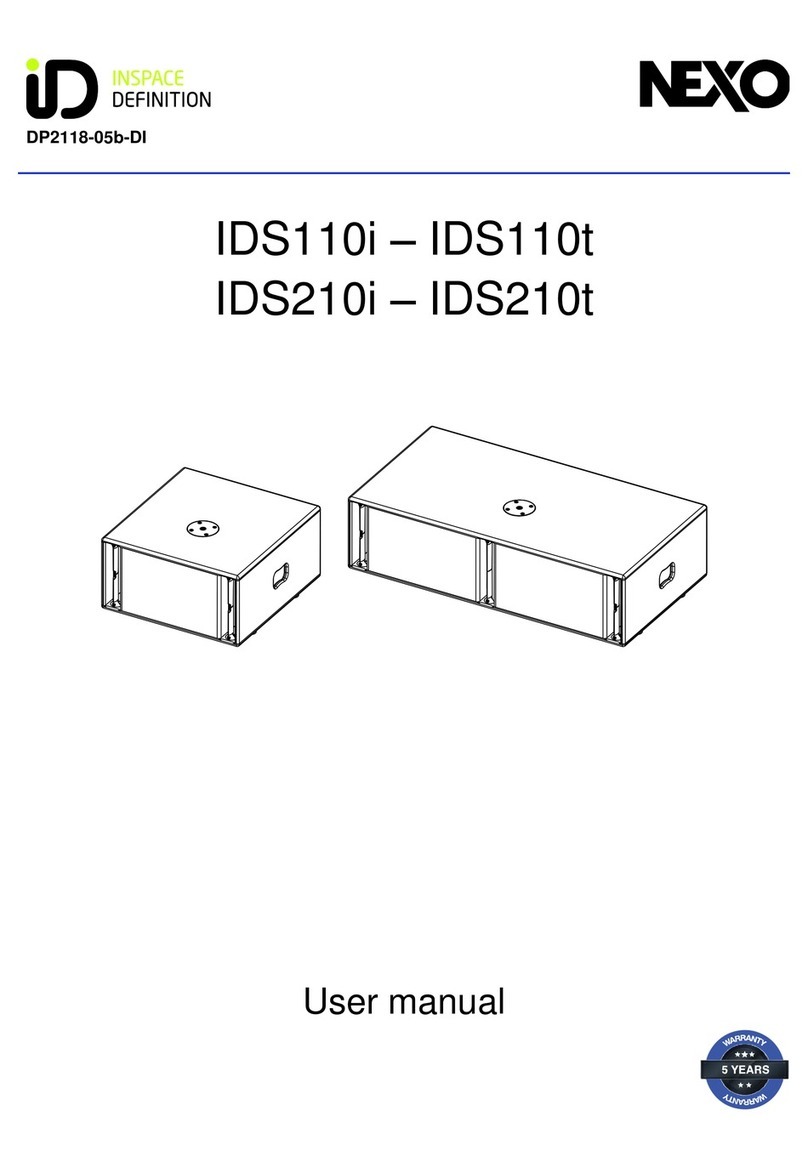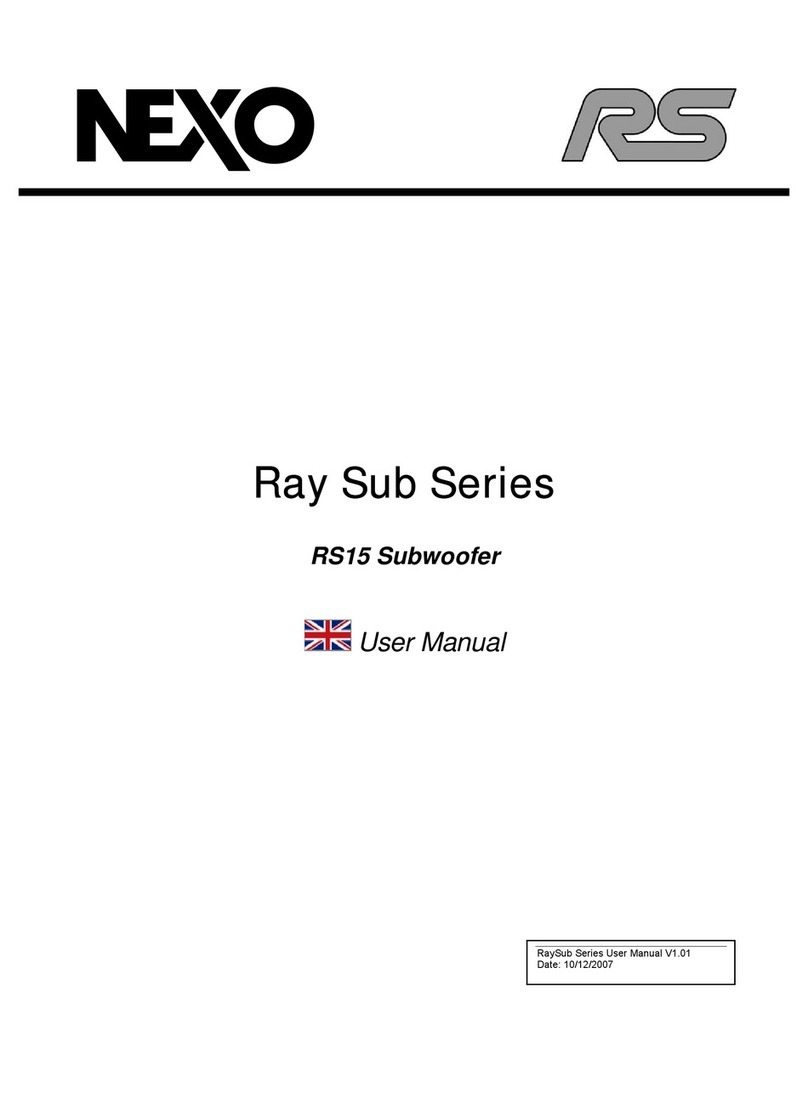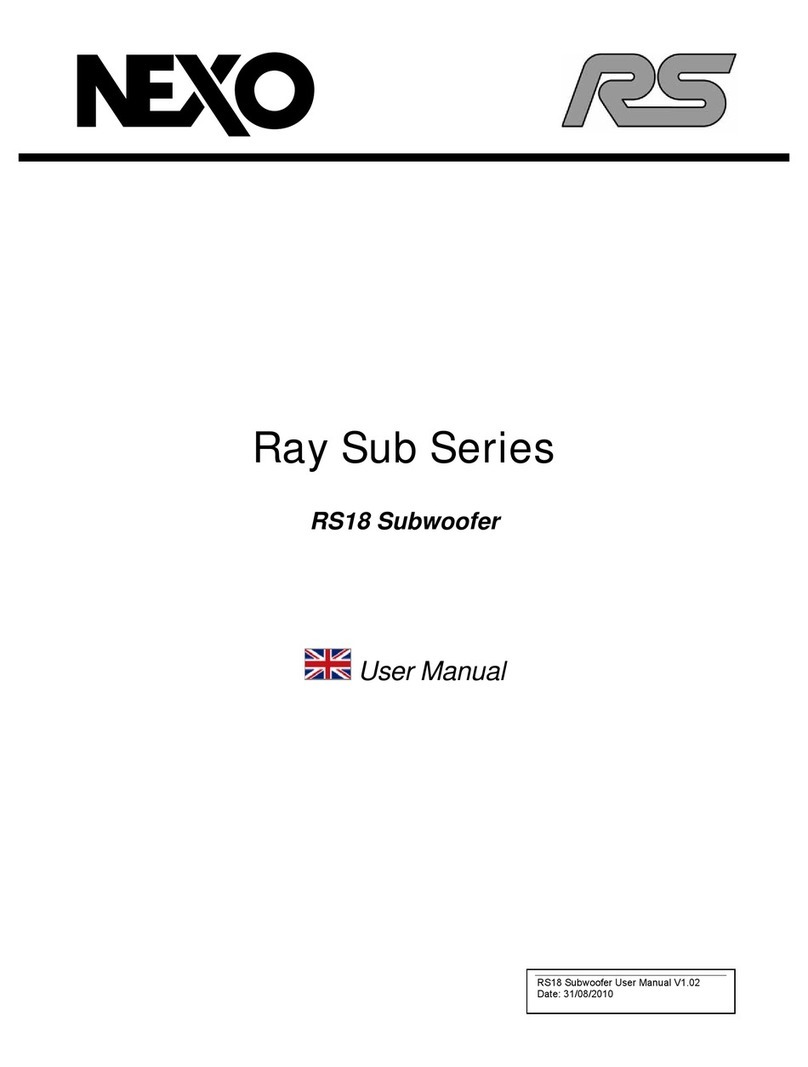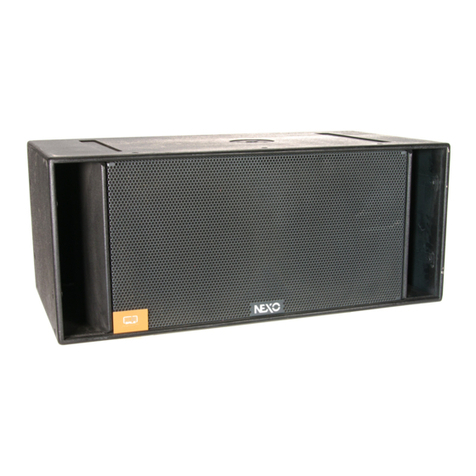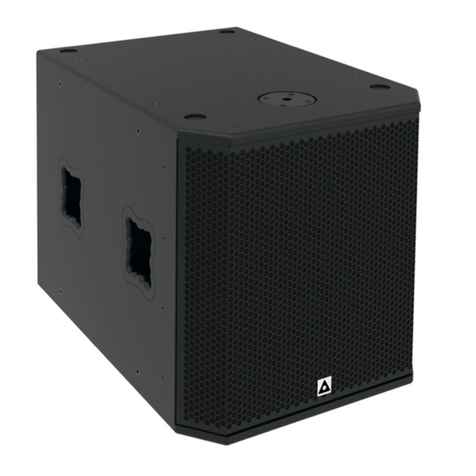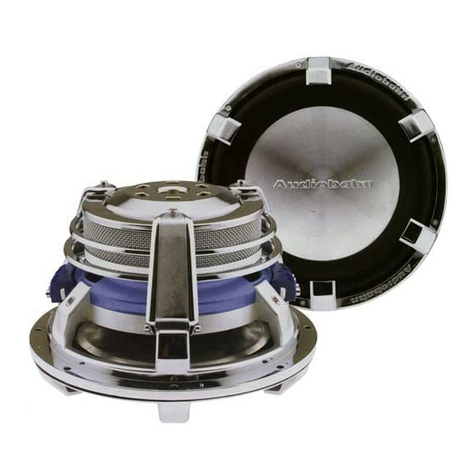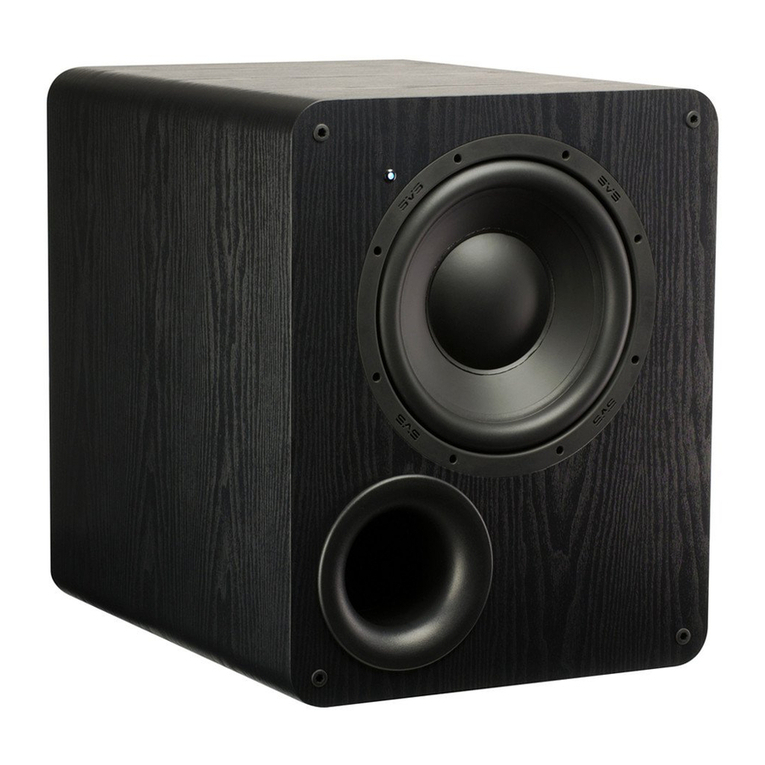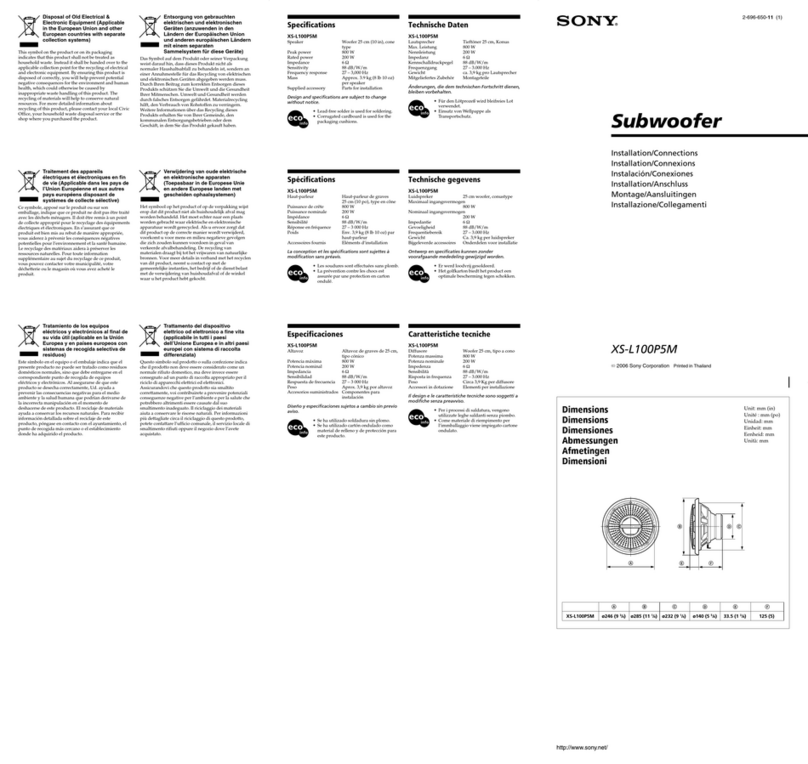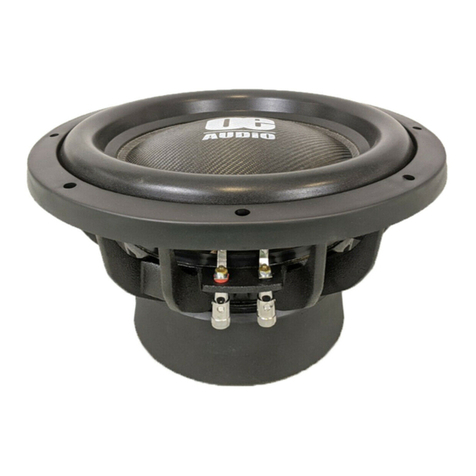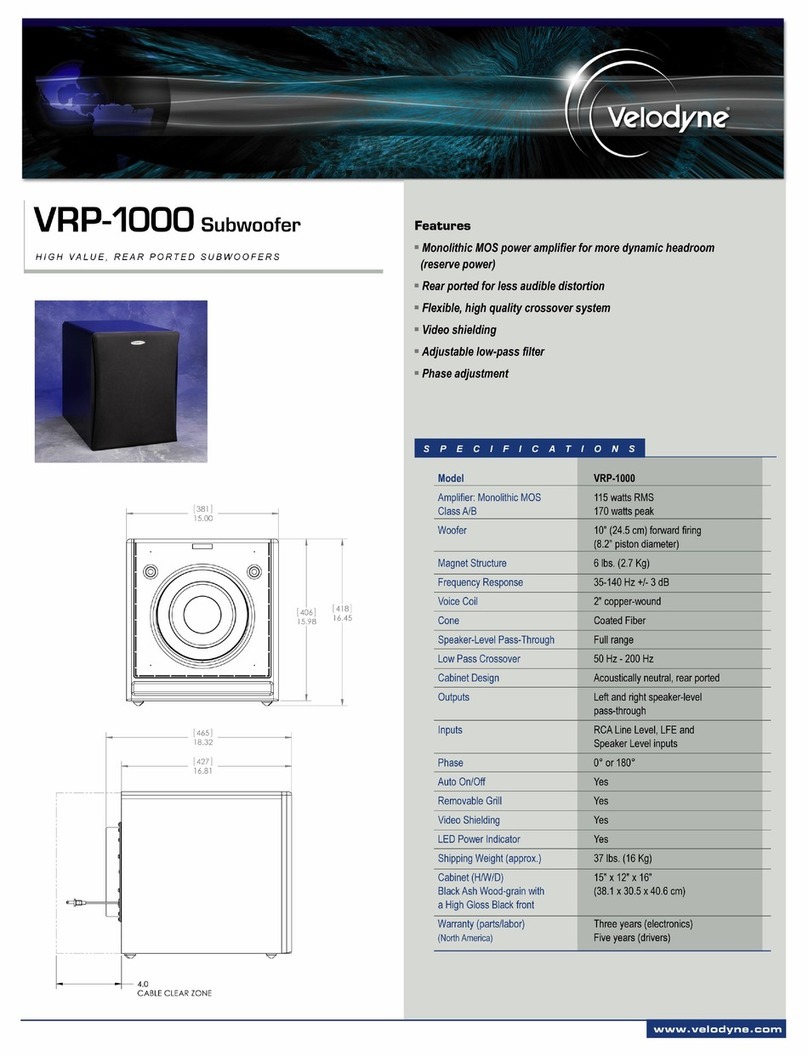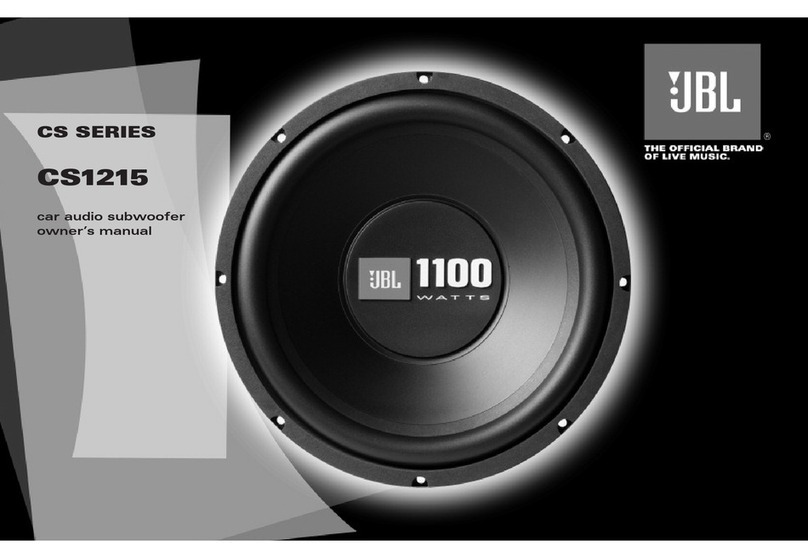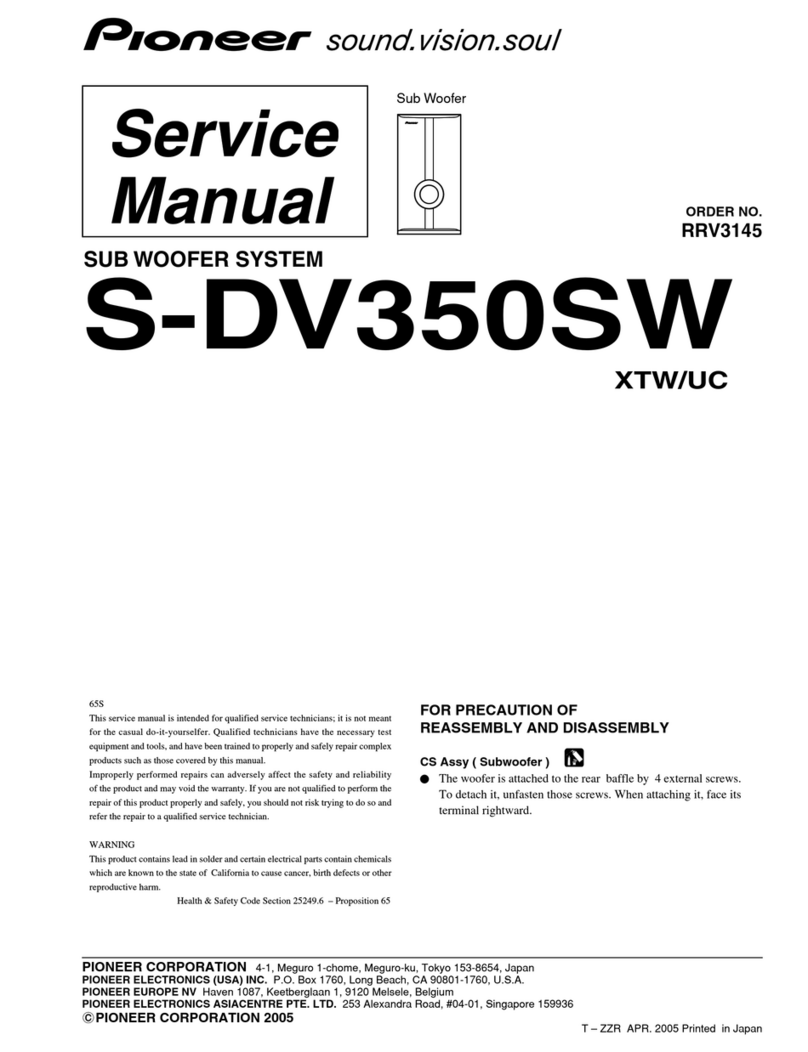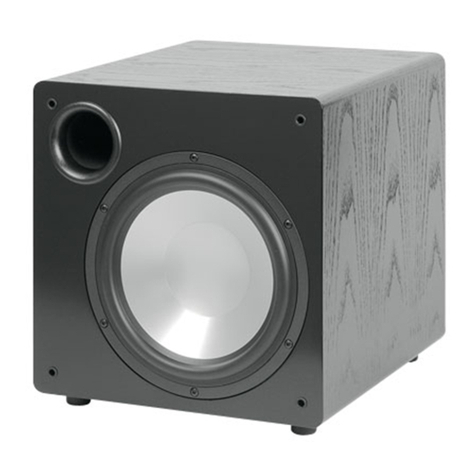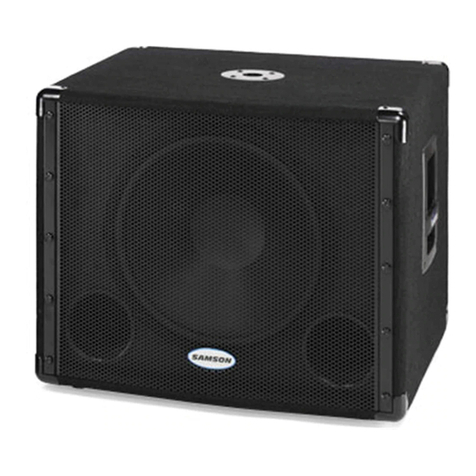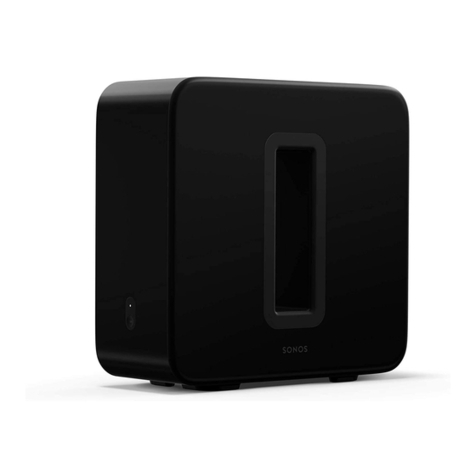Nexo GEO M10 User guide

GEO M10 – MSUB15
GEO M1012 & GEO M1025 Tangent Array Modules
MSub15 Subwoofer
Setup Manual
GEO M10-MSUB15 User Manual V1.02
DP2659 2017/15/02

Page 2/79 PLEASE READ CAREFULLYBEFORE PROCEEDING
GEOTechnologyisradicallynewthinking
The GEO R&D Project has, to date, resulted in the following patent applications:
The GEO Hyperboloid Reflective Wavesource™ differs radically from the megaphone-variant type horns
you know and love (or hate). “Tried and true” methods will produce entirely unexpected results. HRW
technology produces precise and predictable results.
The Configurable Directivity Flange. A waveguide that allows the operator to alter its behaviour. An
unprecedented NEXO development that is easy to use –once you know how and when.
The Phase Directivity Device needs no operator input to function, but it is reassuring to know that the
coupling of the midrange of the system is considered as important as the high frequencies…
DSP-driven Directional Sub-bass devices are a new approach to controlling LF/VLF acoustic energy.
GEO is not hard to use when you understand how…
The technology behind GEO is revolutionary, but it is grounded in years of practical experience with the
problems of delivering high quality professional sound to large audiences at high SPL levels. The GEO
toolbox includes NS-1 - a simple yet powerful and highly predictive design tool. The array assembly
system is keyed to the design software and will easily enable you to deploy your design with great
precision. NEXO Digital TDcontroller technology provide driver protection and system optimization for the
GEO M and MSUB series.
GEOisahighprecisionsystem
The GEO HRW™ controls acoustic energy more precisely than other multiple element waveguides. It
also makes GEO less forgiving of mistakes. Whilst conventional horns never combine into a coherent
array, they may deliver acceptable results even if the design and deployment of the system is less than
optimal. This is not the case with GEO where careless installation produces catastrophic results.
A GEO Tangent Array is not a “line array”
GEO Technology is equally effective in designing and deploying tangent curved vertical arrays. For best
results in a specific application the user needs to know how multi-speaker arrays interact with audience
geometry, along with the benefits and drawbacks of curved vertical arrays and horizontal arrays.
Curvedtangentarraysrequiredifferentdesigntechniques
In the past, sound reinforcement professionals have worked with horizontal arrays that use conventional
horns to deliver [more or less] ‘equal power to equal angles’. Curved vertical arrays are now designed to
deliver [more or less] equal power to equal areas’. When arrays use conventional horns, the lack of
precision, overlap and interference masks errors in array design and aiming. The highly precise GEO
wavesource responds accurately, consistently and predictably to the design and deployment of a curved
vertical tangent array. This is why the GEO rigging system is designed to control angular splay to 0.1°
precision.
GEOcurvedtangentarraysrequiredifferentoperationaltechniques
Over the years, system designers and operators have developed a number of signal processing
techniques to disguise and partly overcome the limitations of horn design. “Frequency shading,”
“amplitude shading,” “High Frequency compensation”, all of these are tools of the advanced sound system
operator. NONE OF THESE TECHNIQUES ARE APPLICABLE TO GEO TANGENT ARRAYS. Instead
of enhancing the array’s performance they will severely degrade it.
Take time to learn how to get great results with GEO Technology. It is an investment that will pay off in
more satisfied clients, more efficient operating procedures and more recognition for your skill as a sound
system designer and operator. A comprehensive understanding of GEO theory, tangent arrays, and
specific features of the GEO M Series will help you to operate your system at its full potential.

PLEASE READ CAREFULLY BEFORE PROCEEDING Page 3/79
PLEASE READ CAREFULLY BEFORE PROCEEDING
BASIC PRECAUTIONS
Do not open the speaker system or attempt to disassemble the internal parts or modify them in any way.
The speaker system contains no user-serviceable parts. If it should appear to be malfunctioning or
damaged, discontinue use immediately and have it inspected by qualified NEXO service personnel.
Water exposure: Do not expose the speaker system to direct rain, do not use it near water or in wet
conditions. Do not place containers with liquid on speaker system as they might spill into openings. If any
liquid such as water seeps into the speaker system, have it inspected by qualified NEXO personnel.
Sun exposure: Do not expose the speaker system to direct sun.
Operating temperature with temperate climate: 0°C to +40°C (-20°C to +60°C for storage).
SYSTEM DEPLOYMENT SAFETY RULES
Read User Manual before deployment. Before use of enclosed speaker system, please
ensure that anyone involved in system deployment understands the rigging –stacking –
pole mounting safety rules as described in the speaker system User Manual. Failure to
do this exposes people to potential injury or death.
Please check the web site nexo-sa.com for the latest update.
Always consult qualified NEXO personnel if the device installation requires construction work and make
sure to observe the following precautions:
Mounting precautions
- choose mounting hardware and an installation location that can support 4 times the weight of the
speaker system;
- do not use speaker system handles for suspended installation;
- do not expose speaker system to excessive dust or vibration, or extreme cold or heat to prevent
possibility of component damage;
- do not place the speaker system in an unstable position from which it might fall accidentally;
- if speaker systems use a stand, ensure that stand specifications are adapted, and that stand height
does not exceed 1.40m/55”; never move the stand while the speaker is in position.
- in case of wind greater than 8 on Beaufort scale (72km/h –45mph), a touring system has to be landed
or an additional securing has to be implemented.
- for fixed installations, wind loading has to be taken into account in accordance to the national
standards.
Connection and powering precautions
- remove all connected cables before moving the speaker system;
- turn off AC power of all power amplifier units before connecting the speaker system;
- when turning on the AC power to the audio system, always turn on the power amplifier last; when
turning the AC power off, always turn off the power amplifier first;
- when used in cold conditions, a gradual power ramp up should applied to the system on an 5 mn
period to allow the loudspeaker components to stabilize during the very first minutes of usage.
Inspect the speaker system periodically.

Page 4/79 PLEASE READ CAREFULLYBEFORE PROCEEDING
HIGH SOUND PRESSURE LEVELS
Exposure to extremely high noise levels may cause permanent hearing loss.
Individuals vary considerably in susceptibility to noise-induced hearing loss but nearly
everyone will lose some hearing if exposed to sufficiently intense noise for a sufficient
period of time. The U.S. Government’s Occupational and Health Administration (OSHA)
has specified the following permissible noise level exposures: Sound Duration Per
Day In Hours
Sound Level dBA, Slow Response
8
90
6
92
4
95
3
97
2
100
1 ½
102
1
105
½
110
¼ or less
115
According to OSHA, any exposure in excess of the above permissible limits could result in some hearing
loss. Ear plugs or protectors to the ear canals or over the ears must be worn when operating this
amplification system in order to prevent permanent hearing loss, if exposure is in excess of the limits as
set forth above. To ensure against potentially dangerous exposure to high sound pressure levels, it is
recommended that all persons exposed to equipment capable of producing high sound pressure levels
such as this amplification system be protected by hearing protectors while this unit is in operation.
DISPOSAL OF OLD ELECTRICAL & ELECTRONIC EQUIPMENT
This symbol on the product or on its packaging indicates that it shall not be treated as
household waste. Instead it shall be handed over to the applicable collection point for
the recycling of electrical and electronic equipment. By ensuring this product is
disposed of correctly, you will help prevent potential negative consequence for the
environment and human health, which could otherwise be caused by inappropriate
waste handling of this product. The recycling of materials will help to conserve natural
resources. For more detailed information about recycling of this product, please
contact your local city office, your household waste disposal service or the shop where
you purchased the product.

CONTENTS Page 5/79
CONTENTS
PLEASE READ CAREFULLY BEFORE PROCEEDING ................................................................................................ 3
CONTENTS ........................................................................................................................................................................... 5
1INTRODUCTION ....................................................................................................................................................... 7
2GEO M10 GENERAL SET-UP INSTRUCTIONS .................................................................................................. 8
2.1 SPEAKER CONNECTION........................................................................................................................................................8
2.1.1 GEO M10 connectors...........................................................................................................................................................8
2.1.2 MSUB15 connectors............................................................................................................................................................8
2.2 CABLING ................................................................................................................................................................................9
2.3 GEO M10 &MSUB15 RECOMMENDED AMPLIFICATION ............................................................................................9
2.4 GEO M10 &MSUB15 SETUPS ON NEXO TD CONTROLLERS ...................................................................................9
3CONNECTION DIAGRAMS................................................................................................................................... 10
3.1 MSUB15 &GEO M10 /DTDCONTROLLER &DTDAMP1.3 ................................................................................. 10
3.2 GEO M10 /NXAMP4X1(4 CHANNELS).................................................................................................................... 10
3.3 GEO M10 /NXAMP4X1(BRIDGE STEREO) ............................................................................................................. 11
3.4 MSUB15 /NXAMP4X1(BRIDGE STEREO)............................................................................................................... 11
3.5 MSUB15 &GEO M10 /NXAMP4X1(BRIDGE STEREO)....................................................................................... 12
3.6 GEO M10 /NXAMP4X4(4 CHANNELS) ................................................................................................................... 13
3.7 MSUB15 OMNI MODE /NXAMP4X4(4 CHANNELS).............................................................................................. 14
3.8 MSUB15 CARDIO MODE /NXAMP4X4(4 CHANNELS).......................................................................................... 15
3.9 MSUB15 &GEO M10 NXAMP4X4(4 CHANNELS) ................................................................................................ 16
4NS-1 SIMULATION SOFTWARE ........................................................................................................................ 17
5CONFIGURABLE DIRECTIVITY DEVICE ......................................................................................................... 18
5.1 INSTALLING &REMOVING GEO’S CONFIGURABLE DIRECTIVITY DEVICES ............................................................. 18
5.2 WHEN &WHERE TO USE CONFIGURABLE DIRECTIVITY FLANGES............................................................................ 19
6GEO M10 HARDWARE SETUP PROCEDURE................................................................................................. 20
6.1 SAFETY FIRST................................................................................................................................................................ 20
6.1.1 Flown Systems Safety......................................................................................................................................................20
6.1.2 Ground Stacking Safety..................................................................................................................................................21
6.1.3 Contacts.................................................................................................................................................................................22
6.2 GENERAL DESCRIPTION................................................................................................................................................... 23
6.2.1 GEO M1012 and GEO M1025.......................................................................................................................................23
6.2.2 GEO M10 rigging system................................................................................................................................................23
6.2.3 GEO M10 “Left” and “Right” configuration...........................................................................................................24
6.2.4 MSUB15 rigging system.................................................................................................................................................24
6.2.5 Accessories ...........................................................................................................................................................................25
6.2.1 WARNINGS ON GEO M10 & MSUB15 ACCESSORIES ........................................................................................26
6.3 GROUND STACK SETUPS................................................................................................................................................... 27
6.3.1 Described configurations...............................................................................................................................................27
6.3.2 GEO M10 only on Lightweight Bumper ..................................................................................................................28
6.3.3 GEO M10 only on Touring Bumper with stacking extensions ......................................................................31
6.3.4 MSUB15 and GEO M10 with Ministack adaptor.................................................................................................34
6.3.5 MSUB15 and GEO M10 on Touring Bumper with stacking extensions....................................................37

Page 6/79 CONTENTS
6.4 FLOWN CLUSTERS SETUPS ...............................................................................................................................................41
6.4.1 Described configurations..............................................................................................................................................41
6.4.2 GEO M10 only flown with Lightweight Bumper.................................................................................................42
6.4.3 GEO M10 flown with Touring Bumper....................................................................................................................46
6.4.4 MSUB15 flown with Touring Bumper.....................................................................................................................50
6.4.5 MSUB15 and GEO M10 flown with Touring Bumper.......................................................................................53
6.5 TESTING AND MAINTENANCE OF THE SYSTEM.............................................................................................................58
7SYSTEM CHECK ALIGNMENT GUIDELINES ...................................................................................................59
7.1 GEO M10 VERTICAL CLUSTER DESIGN.........................................................................................................................59
7.2 STACKED MSUB15 AND FLOWN GEO M10 ...............................................................................................................59
7.3 DRIVING THE MSUB15S FROM THE AUX SEND..........................................................................................................60
7.4 RECOMMENDED INSTALLATION TOOLS AND EQUIPMENT ..........................................................................................60
7.5 GEO M10 –MSUB15 SYSTEM CHECK LIST ...............................................................................................................61
8TECHNICAL SPECIFICATIONS............................................................................................................................62
8.1 MSUB15 SUBWOOFER ....................................................................................................................................................62
8.1.1 System specifications ...................................................................................................................................................... 62
8.1.2 Dimensions (mm/inches).............................................................................................................................................. 62
8.2 GEO M1012 &GEO M1025........................................................................................................................................63
8.2.1 System specifications ...................................................................................................................................................... 63
8.2.2 Dimensions (mm/inches).............................................................................................................................................. 63
8.3 GEO M10 ACCESSORIES ..................................................................................................................................................64
8.3.1 VNT-BUMPM10.................................................................................................................................................................. 64
8.3.2 VNT-EXBARM10................................................................................................................................................................ 65
8.3.3 VNT-GSTKM10L................................................................................................................................................................. 66
8.3.4 VNT-GSTKM10S.................................................................................................................................................................67
8.3.5 VNT-MNSTKM10...............................................................................................................................................................68
8.3.6 GMT-LBUMPM10 ..............................................................................................................................................................69
8.3.7 GMT-EXBARM10L............................................................................................................................................................. 70
8.3.8 GMT-FLGM10......................................................................................................................................................................71
8.3.9 MST-WBMSUB15 ..............................................................................................................................................................72
8.3.10 MST-COVMSUB15........................................................................................................................................................73
8.3.11 MST-2CASEMSUB15................................................................................................................................................... 74
8.3.12 GMT-3CASEM10...........................................................................................................................................................75
8.3.13 GMT-6CASEM10...........................................................................................................................................................76
9GEO M10 & MSUB15 MODULES & ACCESSORIES LIST..............................................................................77
10 USER NOTES............................................................................................................................................................79

INTRODUCTION Page 7/79
1INTRODUCTION
Thank you for selecting a NEXO GEO M10 Series Tangent Array System. This manual is intended to
provide you with necessary and useful information about your GEO M10 & MSub15 System, which
includes the following products:
GEO M1012 is a 12.5° Tangent Array Module. It comprises 1x10”
(25cm) 8 ohms long excursion Neodymium LF/MF driver loaded
by a Phase Directivity Device (PDDTM) and 1x1.4” throat 1driver
16 Ohm HF Neodymium driver loaded by a 6° Hyperboloid
Reflective Wavesource (HRW™).
GEO M1025 is a 25° Tangent Array Module. It comprises 1x10”
(25cm) 8 ohms long excursion Neodymium LF/MF driver loaded
by a Phase Directivity Device (PDDTM) and 1x1.4” throat 1driver
16 Ohm HF Neodymium driver loaded by a 25° Hyperboloid
Reflective Wavesource (HRW™).
MSUB15 is GEO M10 companion subwoofer. It comprises 1x15’’
(38cm) long excursion Neodymium driver, and features very high
efficiency as well as high acoustic output. MSUB15 has fittings for
transporting, flying and stacking.
A full range of accessories provides safe, flexible and simple
means of installing GEO M10 and MSUB15 in fixed installation as
well as in touring applications.
GEO M10 and MSUB15 are controlled, powered and monitored
by NEXO TDcontrollers. For a complete description of these
controllers, please refer to User Manuals. NEXO TDcontrollers
DSP algorithms and parameters are fixed in software and
updated regularly: Please consult the NEXO web site (nexo-
sa.com) for the latest software releases.
NS-1 simulation software assists in the design and
implementation of vertical tangent GEO arrays. Please consult
the NEXO web site (nexo-sa.com) for the latest software
releases.
Available for Mac, iPad and iPhone, NEXO NeMo provides full
remote control over a digital audio network from anywhere in the
venue, thanks to an intuitive and graphically attractive user
interface. NeMo is available on iTunes.
Please devote your time and attention to reading this manual. A comprehensive understanding of GEO
M10 and MSUB15 specific features will help you to operate your system at its full potential.

Page 8/79 GEOM10 GENERAL SET-UP INSTRUCTIONS
2GEO M10 GENERAL SET-UP INSTRUCTIONS
2.1 Speaker connection
GEO M10 and MSUB15 are connected with Speakon NL4FC plugs (not supplied). A wiring diagram is
printed on the connection panel located on the back of each cabinet. The 4 pins of the Speakon sockets
identified in / out are connected in parallel within the enclosure.
Either connector can be used to connect amplifier or to link to an additional GEO M10 cabinet or to link
to an optional MSUB15 (if present). Therefore, a single 4-conductor cable can connect two amplifier
channels to various GEO M10s and/or MSUB15 subwoofers.
2.1.1 GEO M10 connectors
2.1.2 MSUB15 connectors
MSUB15 features 2 connector panels with 2 Speakon NL4 each so that cabling is always done at the
back independently of cabinet being set frontwards or rearwards for cardioid configurations.
Speakon Connector
M1012 & M1025
1(-)
Through
1(+)
Through
2(-)
GEO M10 (-)
2(+)
GEO M10 (+)
Speakon Connector
MSUB15
1(-)
MSUB15 (-)
1(+)
MSUB15 (+)
2(-)
Through
2(+)
Through

GEOM10 GENERAL SET-UP INSTRUCTIONS Page 9/79
2.2 Cabling
NEXO recommends the exclusive use of multi-conductor cables to connect the system: the cable kit is
compatible with all the cabinets, and there is no possible confusion between LF, MF and HF sections.
Cable choice consists mainly of selecting cables of the correct sectional dimension (size) in relation to
the load resistance and the cable length. Too small a cable section will increase both its serial resistance
and its capacitance; this reduces the electrical power delivered to the loudspeaker and can also induce
response (damping factor) variations.
For a serial resistance less or equal to 4% of the load impedance (damping factor = 25), the recommended
cable length is given by:
Lmax = Z x S S in mm2, Z in Ohm, Lmax in meters
The table below indicates these values, for 3 common sizes.
Load Impedance ()
2
3
4
6
8
Cable section
Maximum Length (meters)
1,5 mm² (AWG #14)
3m/10ft
4.5m/13ft
6m/20ft
9m/30ft
12m/39ft
2,5 mm² (AWG #12)
5m/16ft
7.5m/23ft
10m/33ft
15m/49ft
20m/66ft
4 mm² (AWG #10)
8m/26ft
12m/39ft
16m/52ft
24m/79ft
32m/105ft
Maximum allowed length is 4 times recommended length.
Example:
GEO M10 module has a 8 nominal impedance. When connecting 4 modules in parallel, total load
impedance become 2.
Recommended length for 4mm2 / (AWG#10) is 8 m / 26 ft, maximum allowed length is 32 m / 105 ft.
IMPORTANT
Long speaker cables induce capacitive effects –up to hundreds of pF depending on the
quality of the cable - with a low-pass effect on high frequencies. If long speaker cables
must be used, ensure that they do not remain coiled while in use.
2.3 GEO M10 & MSUB15 recommended amplification
NEXO TD Controllers
Recommended amplification
DTD Controller + DTDAMP4x1.3
(4x1.3 kW/4)
2 x GEO M10 per channel
1x MSUB15 per channel
NXAMP4x1 Powered Controller 4 channels mode
(4x1300W/2)
1 x GEO M10 per channel
NXAMP4x1 Powered Controller Bridged Stereo mode
(2x2600W/4)
2 x GEO M10 per bridged channel
2 x MSUB15 per bridged channel
NXAMP4x4 Powered Controller 4 channels
(4x4kW/2)
4 x GEO M10 per channel
3 x MSUB15 per channel
2.4 GEO M10 & MSUB15 setups on NEXO TD Controllers
Please consult nexo-sa.com for NEXO TD Controllers firmware information.

Page 10/79 CONNECTION DIAGRAMS
3CONNECTION DIAGRAMS
3.1 MSUB15 & GEO M10 / DTDController & DTDamp1.3
3.2 GEO M10 / NXAMP4x1 (4 channels)

CONNECTION DIAGRAMS Page 11/79
3.3 GEO M10 / NXAMP4x1 (Bridge Stereo)
3.4 MSUB15 / NXAMP4x1 (Bridge Stereo)

Page 12/79 CONNECTION DIAGRAMS
3.5 MSUB15 & GEO M10 / NXAMP4x1 (Bridge Stereo)

CONNECTION DIAGRAMS Page 13/79
3.6 GEO M10 / NXAMP4x4 (4 Channels)

Page 14/79 CONNECTION DIAGRAMS
3.7 MSUB15 Omni Mode / NXAMP4x4 (4 channels)

CONNECTION DIAGRAMS Page 15/79
3.8 MSUB15 Cardio Mode / NXAMP4x4 (4 channels)

Page 16/79 CONNECTION DIAGRAMS
3.9 MSUB15 & GEO M10 NXAMP4x4 (4 channels)

NS-1 SIMULATION SOFTWARE Page 17/79
4NS-1 SIMULATION SOFTWARE
NS-1 software is a R&D simulation tool derived application. It processes measured speaker data with
complex mathematical algorithms to assist the user in optimizing system design. Due to the complexity
of the interaction of multiple cabinets, it is simply not possible to reliably design curved vertical arrays
without using the processing power of a computer to predict the optimum array structure for a given
audience geometry. The design logic is far more complex than looking at a section drawing of the venue,
measuring the overall angle needed to cover the audience from the cluster location, and dividing by 12
degrees to determine the required amount number of GEO M1012 cabinets.
NS-1 is an easy to use tool that allows to shape the energy leaving the cluster to fit the audience. It
predicts pressure levels radiated from the system to ensure enough cabinets are provided for the
application, as well as mechanical constraints for safe flown systems.
In addition, it provides mechanical information for all clusters in agreement with Structural Analysis
Reports (available in the Help section): dimensions, weight, gravity center position, forces, moments,
working load and safety factor.
GEO M10 and MSUB15 Structural Analysis Report is currently being certified by German Certification
Organization RWTUV systems GmbH.
NS-1 installation package includes all NEXO User Manuals, Structural Analysis Reports and Certificates
PDF files (which can be found in the last section of User Manuals).
NS-1 is a freeware available on nexo-sa.com
IMPORTANT
Never install a GEO M10 and/or MSUB15 cluster without checking its acoustical
performances and mechanical safety in NS-1 prior to installation.
NS-1 GEO M10 ACOUSTIC PAGE

Page 18/79 CONFIGURABLE DIRECTIVITY DEVICE
5CONFIGURABLE DIRECTIVITY DEVICE
The GEO Wavesource controls dispersion of acoustic energy using a hyperboloid acoustical reflector in
the “coupling plane” (the vertical plane of a curved vertical tangent array) and a diffraction slot in the “non-
coupling plane” (the horizontal plane of a curved vertical tangent array). The patented Configurable
Directivity Device consists of flanges that alter the diffraction slot’s exit flare rate.
5.1 Installing & removing GEO’s Configurable Directivity Devices
GEO M10 are shipped in the 80° dispersion configuration, 120° CDDTM flanges are an optional accessory
(GMT-FLGM10).
To change dispersion in the non-coupling plane to 120°:
- Pull the lever to remove the grille on the side (attached with a sling);
- Position the CDDTM flanges on the waveguide output magnetic clips;
- Reinstall the grille and lock it with the lever
To remove the 120° CDDTM flanges:
- Pull the lever to remove the grille on the side (attached with a sling)
- Remove the CDDTM flanges from the waveguide output magnetic clips
- Reinstall the grille and lock it with the lever
NB: In case of GEO M10-I versions, proceed as above by removing the side grille screws

CONFIGURABLE DIRECTIVITY DEVICE Page 19/79
5.2 When & where to use Configurable Directivity flanges
The diagrams show audience area coverage for a stereo system. While the GEO cluster will deliver even
SPL from the front to the rear of this audience area, there are “holes” near the front in the centre and at
the outside edges. We cannot fill the outside coverage gaps without enlarging the centre gap, and vice
versa (left figure below).
If 120° Configurable Directivity Devices are installed at the bottom cabinet of the clusters, coverage will
look more like the pattern in right figure below.
-6dB coverage, all GEO M10 in 80° configuration
-6dB coverage, bottom GEO M10 in 120° configuration
In curved vertical arrays, the 120° Configurable Directivity Device can be used:
On the bottom row of curved vertical arrays, to fill in coverage gaps in the front rows.
On all rows of curved vertical arrays, in cases where 120° of horizontal coverage is preferred
to 80°.
IMPORTANT
Installing or removing one of the two flanges anticipating asymmetrical coverage will
degrade both coverage and frequency response.

Page 20/79 GEOM10 HARDWARE SETUP PROCEDURE
6GEO M10 HARDWARE SETUP PROCEDURE
Before proceeding with assembly of GEO M10 & MSUB15 arrays, please ensure that the components
are present and undamaged. A component list is appended to this manual. In the event of any shortage,
please contact your supplier.
For maximum efficiency the GEO M10 & MSUB15 rigging system requires three experienced persons for
set-up: typically one motor hoist operator, and one operator per side of the array. Good synchronisation
and crosscheck between the operators are key elements for a reliable and safe set-up.
6.1 SAFETY FIRST
GEO M10 & MSUB15 Rigging System structural computations and related documents are available in
NS-1 or at Nexo ([email protected]) upon request.
We include this section to remind you of safe practice when flying the GEO M10 & MSUB15 system.
Please read it carefully. However, user must always apply his or her knowledge, experience and common
sense. If in any doubt, seek advice from your supplier or NEXO agent.
This manual offers guidance only for GEO M10 & MSUB15 loudspeaker systems. References in this
manual to other rigging equipment such as motor hoists, steels, shackles etc. are made to clarify the
description of rigging procedures. The user must ensure that operators are properly trained by other
agencies in the use of these items.
The GEO M10 & MSUB15 Rigging System has been optimised for the deployment of curved vertical
tangent arrays of GEO M10 & MSUB15 loudspeakers. Angle adjustment between cabinets has been
limited to specific settings to ensure correct acoustic coupling.
The GEO M10 & MSUB15 Rigging System is a professional precision tool set, and should be handled
with extreme care. Only persons who are fully conversant with the operation of the GEO M10 & MSUB15
Rigging System and provided with suitable safety equipment should deploy GEO Arrays. Misuse of the
GEO M10 & MSUB15 Rigging System could lead to dangerous consequences.
Used and maintained correctly, the GEO M10 & MSUB15 Rigging System will give many years of reliable
service in portable systems. Please take the time to read and understand this manual. Always use NS-1
to determine the optimum angle settings for a particular venue, hang point and curved vertical GEO M10
& MSUB15. Applied forces and moments are strongly cabinet quantity and angle configuration
dependent. Cluster configuration must be implemented and validated in NS-1 prior to installation.
6.1.1 Flown Systems Safety
Always inspect all the rigging components and cabinets for damage before assembly. Pay special
attention to the lifting points, and safety clips. If you suspect that any of the components are damaged or
defective, DO NOT USE THE AFFECTED PARTS. Contact your supplier for replacements.
Read this manual carefully. Also be familiar with the manuals and safe working procedures for any
ancillary equipment that will be used with the GEO M10 & MSUB15 Rigging System.
Applied forces and moments are strongly cabinet quantity and angle configuration dependent. Cluster
configuration must be implemented and validated in NS-1 prior to installation.
Ensure that all local and National regulations regarding the safety and operation of flying equipment are
understood and adhered to. Information on these regulations can usually be obtained from Local
Government Offices.
When deploying a GEO M10 & MSUB15 system always wear protective headwear, footwear and eye
protection.
Do not allow inexperienced persons to handle a GEO M10 & MSUB15 system. Installation personnel
should be trained in loudspeaker flying techniques and should be fully conversant with this manual.
Other manuals for GEO M10
2
This manual suits for next models
3
Table of contents
Other Nexo Subwoofer manuals
